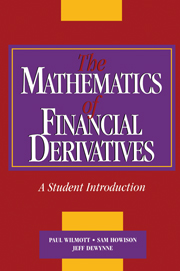Book contents
- Frontmatter
- Contents
- Preface
- Part One Basic Option Theory
- 1 An Introduction to Options and Markets
- 2 Asset Price Random Walks
- 3 The Black–Scholes Model
- 4 Partial Differential Equations
- 5 The Black–Scholes Formulæ
- 6 Variations on the Black–Scholes Model
- 7 American Options
- Part Two Numerical Methods
- Part Three Further Option Theory
- Part Four Interest Rate Derivative Products
- Hints to Selected Exercises
- Bibliography
- Index
2 - Asset Price Random Walks
from Part One - Basic Option Theory
Published online by Cambridge University Press: 05 June 2012
- Frontmatter
- Contents
- Preface
- Part One Basic Option Theory
- 1 An Introduction to Options and Markets
- 2 Asset Price Random Walks
- 3 The Black–Scholes Model
- 4 Partial Differential Equations
- 5 The Black–Scholes Formulæ
- 6 Variations on the Black–Scholes Model
- 7 American Options
- Part Two Numerical Methods
- Part Three Further Option Theory
- Part Four Interest Rate Derivative Products
- Hints to Selected Exercises
- Bibliography
- Index
Summary
Introduction
Since the mid-1980s it has been impossible for newspaper readers or television viewers to be unaware of the nature of financial time series. The values of the major indices (Financial Times Stock Exchange 100, or FT-SE, in the UK, the S&P 500 and Dow Jones in the US and the Nikkei Dow in Japan) are quoted frequently. Graphs of these indices appear on television news bulletins throughout the day. As an extreme example of a financial time series, Figure 2.1 shows the FT-SE daily closing prices for the six months each side of the October 1987 stock market crash. To many people these ‘mountain ranges’ showing the variation of the value of an asset or index with time are excellent examples of ‘random walks’.
It must be emphasised that this book is not about the prediction of asset prices. Indeed, our basic assumption, common to most of option pricing theory, is that we do not know and cannot predict tomorrow's values of asset prices. The past history of the asset value is there as a financial time series for us to examine as much as we want, but we cannot use it to forecast the next move that the asset will make. This does not mean that it tells us nothing. We know from our examination of the past what are the likely jumps in asset price, what are their mean and variance and, generally, what is the likely distribution of future asset prices.
- Type
- Chapter
- Information
- The Mathematics of Financial DerivativesA Student Introduction, pp. 18 - 32Publisher: Cambridge University PressPrint publication year: 1995



